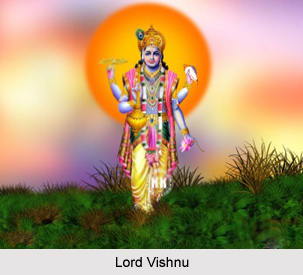 In the basic Hindu Trinity of gods, Lord Vishnu, Lord Brahma and Lord Shiva, the Hindu god Vishnu is the preserver and protector of creation. The Lord, an embodiment of mercy and goodness, is all-pervading. Vishnu is most famous for having ten avatars or incarnations of him. The Lord is revered and flanked by several attendants mentioned below:
In the basic Hindu Trinity of gods, Lord Vishnu, Lord Brahma and Lord Shiva, the Hindu god Vishnu is the preserver and protector of creation. The Lord, an embodiment of mercy and goodness, is all-pervading. Vishnu is most famous for having ten avatars or incarnations of him. The Lord is revered and flanked by several attendants mentioned below:
Garuda
Garuda, one of the three principal animal deities in the Hindu Mythology, two being Ganesha and Hanuman, reigns over the birds and is the mount of Lord Vishnu. A half-man and half eagle also known as Garutman, Garuda according to the Indian Puranas is the son of rishi Kashyapa and Vinata, one of the daughters of Daksha. Garuda married Unnati and from her descended the serpent eating birds. The serpent, depicted as a huge, strong golden coloured or sometimes white coloured bird, is a fervent enemy of the snakes. His eyes are red and shining while his head is of an eagle with a red beak having feathery wings. His belly is large and his arms are like those of a man. He is usually shown with two arms but sometimes with four, eight or sixteen arms and mostly exhibited devouring a snake. The serpent is known by five names: Chirada, Gaganeshvara, Kamayusha, Kashyapi, Khageshvara, Nagantaka, Sitanana, Sudhahara, Suparna, Tarkshya, Vainateya, Vishnuratha and others. Garuda had six sons; one of the sons is famous Jatayu, a significant character in Ramayana.
Ananta
Lord Vushnu, in his aroused state, is seen riding a Garuda while when the creation is withdrawn he is seen sleeping on a thousand headed gigantic serpent known as Ananta, the endless or Shesa naag, the remainder. The Ananta, seen floating over the ocean representing the universe, is among the chief attendants of Lord Vishnu. It represents the eternity of time`s endless revolutions. This thousand hooded protective umbrella follows its Lord as a sign of royalty. The Ananta serves as the seat when Vishnu is seated, it serves as the couch when the Lord reclines while in the Yoganidra period when Vishnu reposed on the ocean of Milk it served as the buoyant support. White in colour, Ananta is depicted seated on the primordial tortoise with the conch and the discus as his standard feature and bearing a plough, a lotus, a rosary and a pestle.
The city of Anantanag in Kashmir, named after the serpent Ananta Naag, is thought to be the original abode from times immemorial. Till today there is an ancient temple dedicated to him, depicting the massive coils of the serpent.
Vishvakshena
Vishvakshena is the commander-in-chief of the divine forces in Vaishnava temples. Devotees, before offering veneration to Lord Vishnu, approach Vishvakshena for worship. Round bellied, he possesses two to four hands holding a conch, a discus and a mace and one hand he displays comforting gesture or the Jnana mudra. He is dark complexioned, red haired with broad nose while white teeth are being revealed by a smile. His curved eyebrows and pointed nails further denote his features. Crowned with a resplendent diadem, Vishvakshena has a benign nature but occasionally portrays flashes of anger.
Sudarshana
Sudarshana is the personified protective discus of Lord Vishnu. The iconography of Lord Vishnu depicts him standing in a circle of a flaming wheel possessing 4, 8, 16 or 32 hands with the discus in his right hand. His colour is that of flame and his idol is usually made of gold, silver or copper.
Jaya-Vijaya
Jaya-Vijaya serve as two attendants or door keepers of Lord Vishnu`s celestial abode Vaikuntha. Once, they infuriated some sages and were thus, cursed by them to be born as either mortal on earth for six times or thrice as asuras upon which they would be granted the right to return to Vaikuntha. They however, chose to be born as asuras that turned them against Vishnu, but being the fervent devotees of Vishnu, they could return to his service within a short span of time.
They were therefore, born as brothers Hiranyaksha and Hiranyakashipu during the Narasimha Avatara, as Ravana and Kumbhakarna in Ram avatar, and as Kansa and Shishupala in Krishna avatar. After their death as Kansa and Shishupala the asura cycle of birth and re-birth of Jaya and Vijaya was over and they re-entered Vishnu`s heaven and regained their place as His door keepers. As per another account Jaya and Vijaya took birth as Hiranyaksha and Hiranyakasipu; Madhu and Kaitabha; and Shishupala and Dantavakra.




















